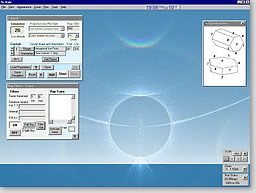|
| |
All the website simulations were produced by HaloSim. It may be freely
downloaded.
It creates simulations by accurately tracing up to several million
light rays through mathematical models of ice crystals.
HaloSim3 is the result of a transatlantic collaboration by Les
Cowley and Michael Schroeder. |
 |
- Simulations
can be run immediately. Select from ready to
run simulations of common and rare halos with text descriptions.
- Crystals.
Halos from all crystals are simulated; hexagonal plates, columns,
pyramidals and non water-ice crystals which might be found in
other planetary atmospheres.
- Orientations.
Files for plate, singly oriented columns, Parry and Lowitz orientations
included. Others can be generated. Axial dispersions and dispersion
distributions can be specified.
- All
halos simulated. All the possible light paths
through crystals are sampled, hence all halos for a given solar
altitude and crystal type/alignment are simulated.
- Complex
halo displays are simulated. HaloSim simultaneously
computes up to twelve crystal-orientation combinations.
- Ray
filtering and tracing tools allow particular
halos to be isolated and their formation investigated.
- Crystal
tool kit Tools to automatically generate custom
crystal orientation files and pyramidal crystals of any proportions.
- Fisheye,
plan and camera projections centered on the zenith,
nadir, sun or a user defined position. Views can be zoomed.
- High
definition graphics. Full colour, grey-scale
simulations against backgrounds of choice. Also traditional
black dots on white.
- Simulations
parameters stored. The simulation parameters
can be stored with a text description for subsequent retrieval.
Settings, including zoom conditions and colours, are restored
on playback.
- Custom
interface settings. Control appearance and behaviour
can be set by the user.
|
|
|
